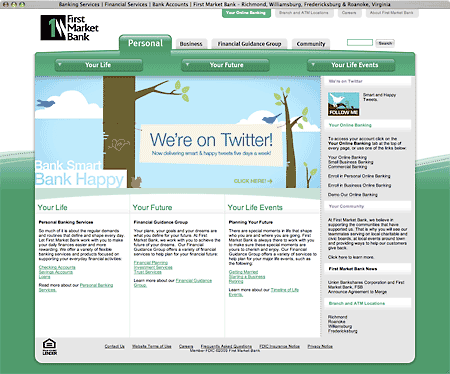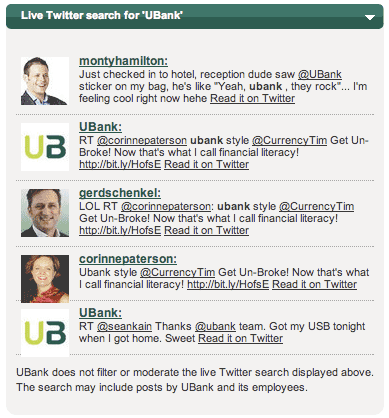“Twitter is very hot right now. There’s been a major uptake in activity.”
— James McGovern,
Corporate Insight
First Market Bank in Richmond, Virginia, is one of the latest. They just launched their Twitter project earlier this month. They made a big splash about it on their homepage. So far, @FirstMarketBank has sent out 48 tweets to their 123 “followers.”
1st Market Bank’s announcement about Twitter on its homepage.
 UBank gave a 1GB USB drive to the first 1,000 people who followed them on Twitter. The contest was limited to residents of Australia where the bank is based. UBank also has an unfiltered stream of tweets on its website including all comments — good and bad — about UBank.
UBank gave a 1GB USB drive to the first 1,000 people who followed them on Twitter. The contest was limited to residents of Australia where the bank is based. UBank also has an unfiltered stream of tweets on its website including all comments — good and bad — about UBank.
UBank’s has a live, unfiltered stream of tweets about the bank on its website.

Navigating the Role of AI in Financial Institutions
83% of FI leaders agree investing in AI is essential for 2024 but how you leverage AI is instrumental in success and meeting customer expectations.
Read More about Navigating the Role of AI in Financial Institutions

Industry Cloud for Banking from PwC
PwC’s Industry Cloud for Banking applies our deep industry knowledge to your specific business needs
When BofA put one of its employees, David Knapp, on Twitter, it became the first financial institution to use the service specifically for customer service. Knapp has made BofA the most active financial institution on Twitter, sending as many as 200 messages a month to customers publicly, and presumably hundreds more privately . The response has been very positive. There are dozens upon dozens of thank you notes penned by customers to @BofA_help on Twitter. Recently, BofA polled customers to see what they thought of the bank’s service on Twitter. 79% of respondents were satisfied.
Now, other financial institutions like Wells Fargo are following BofA’s footsteps with a similar customer service strategy. There have been seven different people staffing Wells Fargo’s Twitter account: Haila, Ruby, Ian, Kimarie, Chastity, Jay and Joel. And Umpqua uses at least four different staffers.
Four of Wells Fargo’s seven customer service reps on Twitter.
From left to right: Haila, Joel, Kimarie and Chastity.
“Social media is a whole new world, and you cannot afford to not be a part of it.”
— Pamela Blase,
UMB Financial
In the wake of the financial crisis, people have become increasingly sensitive to their finances. Wells Fargo sees Twitter as a way to reassure customers. “There’s a lot of worry out there,” Ed Terpening, VP Social Media/Wells Fargo told USA Today. “That means that we have to stay close to our customers.”
What BofA and Wells Fargo have realized it that every time they go out and resolve a customer issue on Twitter, they are potentially saving a relationship. These financial institutions understand the dollar-cost associated with lost customers, and see substantial value in the goodwill they are generating. Instead of having angry customers complaining to all their friends, banks and credit unions on Twitter are fostering all kinds of positive word-of-mouth buzz.
“Some financial institutions are doing a much better job of embracing Twitter and utilizing its capabilities.”
— Scott Mills, President
William Mills Agency
Customer service on Twitter is an idea that’s gaining traction. Wachovia, an early adopter of Twitter in the financial industry, struggled for months to find its footing and put any real purpose to its Twitter presence. But earlier this year, they made the switch to answering customer questions and resolving issues, and now they’ve hit a stride. Their last 60 tweets have all been customer focused.
To learn more about how financial institutions are using Twitter, pick up your copy of “Connecting to Customers with Twitter: The Comprehensive Guide to Twitter for Financial Institutions,” by Jeffry Pilcher, Publisher of The Financial Brand. It’s 80 pages of strategies, analysis, examples and how-to advice.










